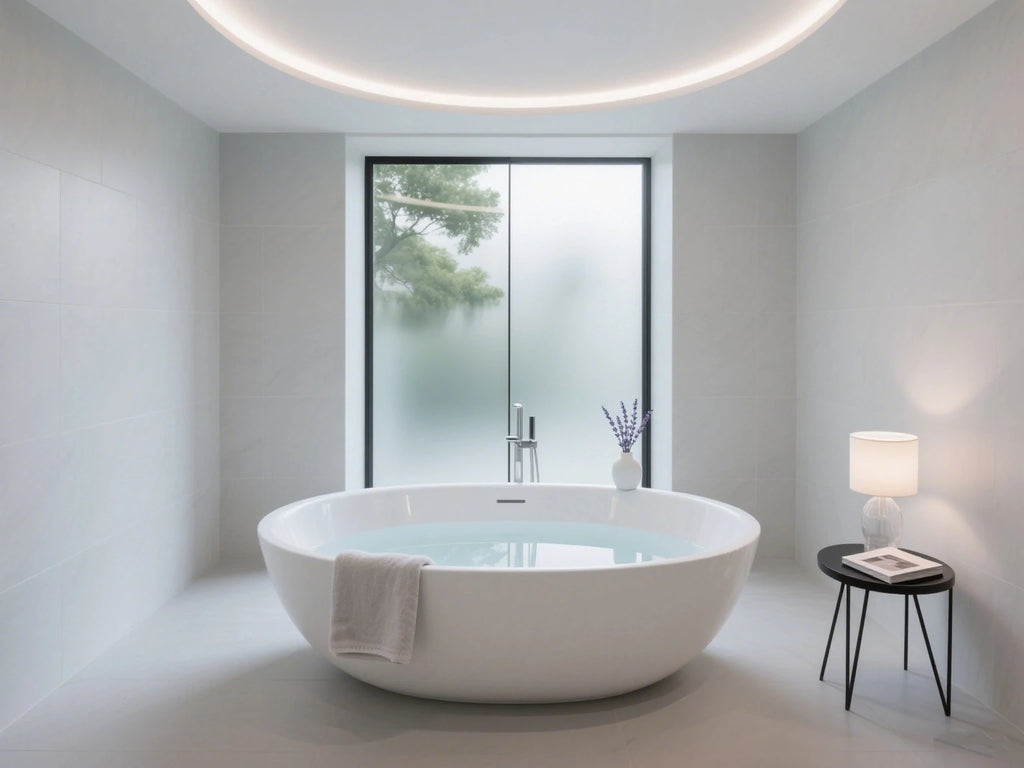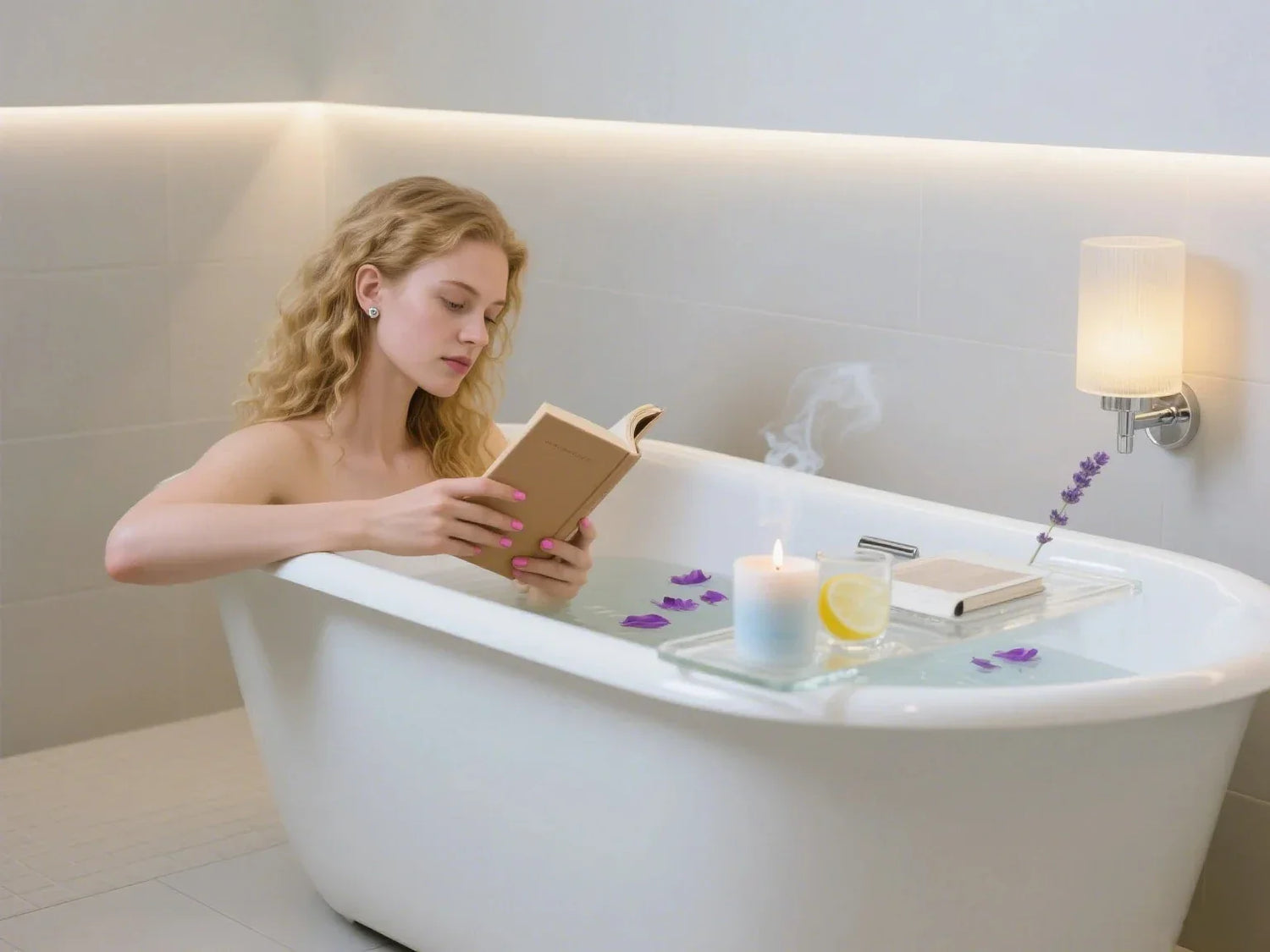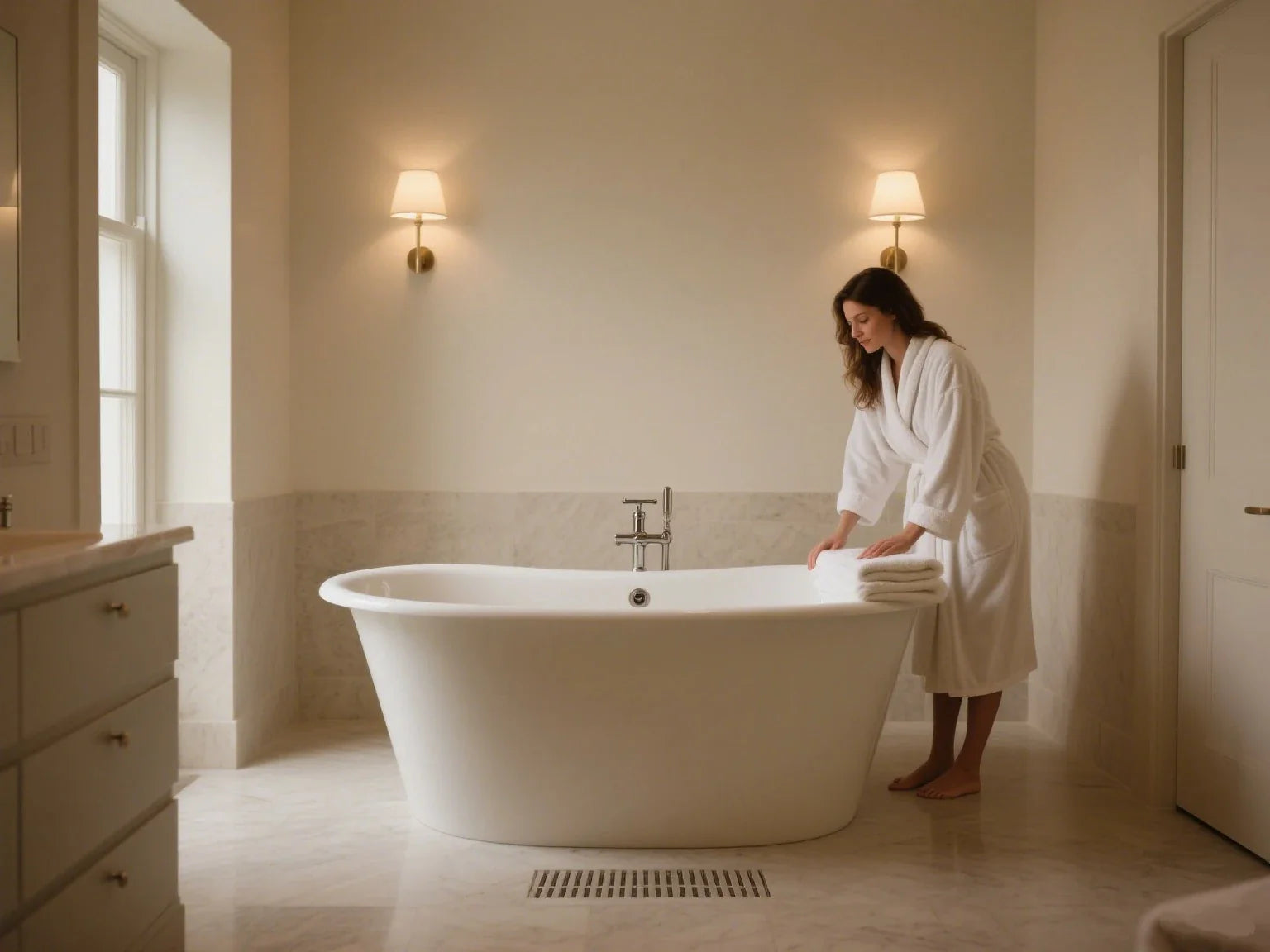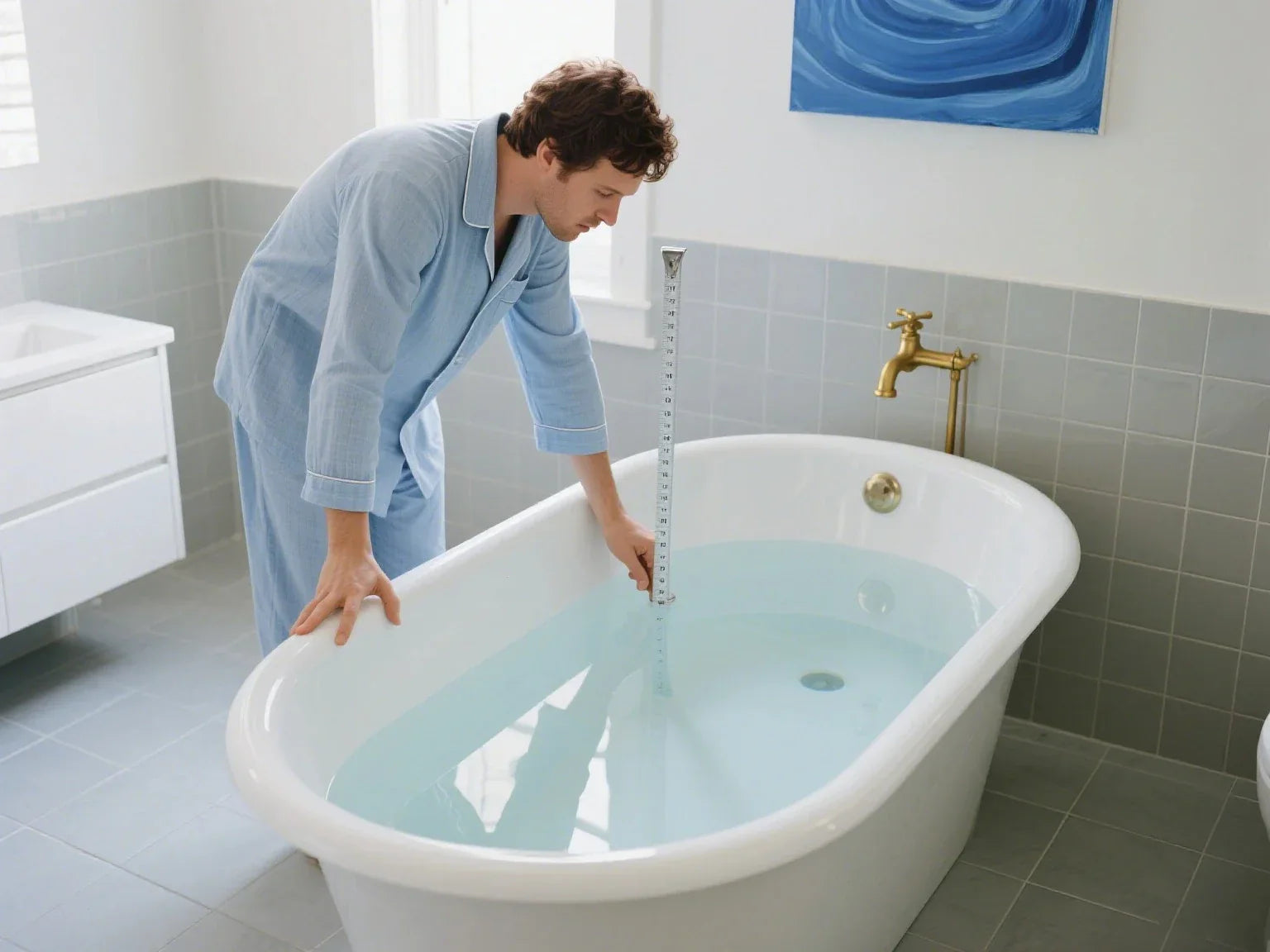Bathtub Acrylic vs Fiberglass vs Porcelain: Quick Answer
Best overall value: Acrylic
- Combines durability, excellent heat retention, and wide design flexibility.
- Average lifespan: 10–15 years; surface scratches are usually easy to repair.
- Lightweight; easy to install; mid-range price ($600–$1200 installed).
- Great fit for primary/family bathrooms seeking long-term value.
Lowest upfront cost: Fiberglass
- Cheapest to buy and install; very lightweight and DIY-friendly.
- Shortest lifespan: roughly 5–10 years; prone to cracking, fading, warping.
- Better suited for guest bathrooms or low-use spaces.
Longest lifespan and classic look: Porcelain (enamel over steel or cast iron)
- Hard, glossy surface; highly resistant; moderate heat retention.
- Chips can expose metal and cause rust (steel base); heavy install needs.
- Porcelain tubs are known for their exceptional longevity, with a lifespan that can exceed 20 years; higher purchase + install cost, especially cast iron.

What is the Best Material for a Bathtub? (at-a-glance)
Snapshot of performance (weight, durability, heat, lifespan)
- Weight: Fiberglass (lightest) < Acrylic (light) << Porcelain (heaviest).
- Durability: Porcelain (hardest surface) > Acrylic (durable) > Fiberglass (least).
- Heat retention: Acrylic (excellent) > Porcelain (moderate) > Fiberglass (poor).
- Life expectancy: Porcelain 20+ years > Acrylic 10–15 years > Fiberglass 5–10 years.
Quick comparison table
| Feature | Acrylic | Fiberglass | Porcelain (Steel or Cast Iron Base) |
| Badge | ⭐ Best Value | 💰 Budget Pick | 🕰 Longest Lifespan |
| Weight | Light | Lightest | Heaviest |
| Durability | Strong, reinforced with fiberglass | Least durable; can flex | Hardest, most scratch-resistant |
| Heat Retention | Excellent; warm to the touch | Poor; loses heat fast | Moderate; feels cool to touch |
| Lifespan | ~10–15 years | ~5–10 years | 20+ years if maintained |
| Cost (Installed) | ~$600–$1200 | ~$400–$800 | Steel: ~$700–$1000; Cast iron: $1500+ |
| Repairs | Scratches polish out | Cracks/warps harder to hide | Chips can rust; pro repair best |
| Design/Shapes | Widest range, modern | Basic shapes, budget lines | Classic shapes; fewer options |
| Install Ease | Easier to install | Easiest, very light | Hardest; weight and access issues |
Cost bands and install implications
- Acrylic: ~$600–$1200 installed; many shapes and sizes; common in remodels.
- Fiberglass: ~$400–$800 installed; best for tight budgets; shorter service life.
- Porcelain: These tubs are more expensive. Steel ~$700–$1000; cast iron $1500+; expect higher labor due to weight.
Which tub material retains heat best?
- Acrylic: Best for soaking; water stays warm longer.
- Porcelain: Middle of the pack; feels cooler than acrylic.
- Fiberglass: Loses heat quickly; water cools faster.
Acrylic Bathtubs: Construction, Pros/Cons, Best Uses
How acrylic tubs are made and why it matters
- Construction: A molded acrylic sheet is shaped, then reinforced with fiberglass resin for rigidity.
- Design freedom: Acrylic bathtubs also offer many shapes, sizes, and colors, allowing sleek, modern bathroom designs.
- Installation: Lightweight and easier to carry through doors or up stairs.
Pros and cons with numbers
- 10–15 year expected life with normal use.
- Excellent heat retention for longer, warmer baths.
- Easy scratch repair with polishing or DIY kits.
- Strong value for most primary baths.
- Can scratch if scoured with abrasive pads.
- Costs more than fiberglass.
- Not as “heirloom” or heavy-duty in feel as cast iron porcelain.
Is acrylic more durable than fiberglass?
Best-fit scenarios
- Family bathrooms used every day.
- Soakers who value warmer water and a smooth, warm-touch surface.
- Mid-budget remodels where install simplicity matters.
- Homes wanting modern designs and more size options.

Fiberglass Bathtubs: Budget Pick With Trade-offs
What to expect over 5–10 years
- Lowest upfront cost.
- Lightest weight; easiest to carry and place.
- DIY-friendly installs in many cases.
- Gel coat can wear, leading to a rough feel or discoloration.
- less durable, prone to flexing, cracks, and warping under heavy use.
- Often replaced sooner than other types.
Common failure modes and repairs
- Surface cracking around stress points.
- Flexing that can break caulk lines and cause leaks.
- Fading when harsh cleaners are used.
Can you refinish a fiberglass tub?
When fiberglass makes sense
- Guest baths or powder rooms with low use.
- Rental turnovers with a tight budget.
- Quick flips where short service life is acceptable.

Porcelain-Enamel Tubs: Cast Iron vs Steel
Construction differences and feel
Porcelain enamel is a glass-like enamel coating fused to either:
- Steel (lighter than iron).
- Cast iron (very heavy; premium feel).
The surface is hard, glossy, and scratch-resistant.
Feels cooler and firmer than acrylic. Cast iron dampens noise well and feels very solid.
Pros and cons (plus costs)
- Classic look; suits traditional and vintage-style bathrooms.
- 20+ year potential lifespan with proper care.
- Highly scratch-resistant surface.
- Chips can expose metal, leading to rust (especially with steel base).
- Repairs for chips are more involved and often need a pro.
- Heavy; delivery, floor load, and install work can add to cost.
- Porcelain over steel: mid-range purchase and install.
- Cast iron: premium product with higher labor.
Do porcelain tubs chip easily?
Installation challenges and planning
- Weight can require floor reinforcement, especially for cast iron.
- Access (stairs, tight corners) may need extra labor or tools.
- Plan disposal of the old tub and safe handling for the new one.

Installation, Weight, and Structural Needs (DIY vs Pro)
DIY vs professional install: tools, time, risk
- These tubs are lightweight, easier for DIY with standard plumbing tools.
- Light enough for two people in many cases.
- Lower risk to floors and walls during moving.
- Professional install is smart due to weight and handling risk.
- May need crew or special equipment.
- Check floor structure and access route before purchase.
Weight and floor load basics
- Fiberglass: Lightest; lowest structural concern.
- Acrylic: Light; often fine for upstairs baths.
- Porcelain over steel: Medium weight; check joist spans in older homes.
- Cast iron: Significantly heavier than acrylic tubs; may need joist and subfloor checks and reinforcement.
Do I need floor reinforcement for cast iron?

Noise, comfort, and user experience
- Acrylic: Warm to the touch, smooth.
- Porcelain: Cool and hard, very solid underfoot.
- Fiberglass: Light, can feel a bit hollow.
Cost and Lifetime Value (TCO) Calculator Framework
Initial purchase + installation ranges
Fiberglass: ~$400–$800 installed.
Acrylic: ~$600–$1200 installed.
Porcelain:
- Steel: ~$700–$1000 installed.
- Cast iron: $1500+ installed, often more with reinforcement.
10–20 year total cost of ownership scenarios
Fiberglass (guest bath, 10 years):
- Low use, low repairs.
- Replacement may be needed by year 5–10.
- TCO is low at first but rises if replaced early.
Acrylic (primary bath, 10–15 years):
- Moderate upfront.
- Minimal repairs (scratch polish).
- Replacement near year 10–15.
- Strong value for daily use.
Porcelain (legacy bath, 20+ years):
- High upfront + delivery/structural costs.
- Occasional chip repair.
- No replacement within 20 years.
- Best for long-term plans.
Which tub material is cheapest to maintain?
- Acrylic: Easy to maintain with simple DIY scratch fixes.
- Fiberglass: Cheap to clean, but repairs and earlier replacement can add up.
- Porcelain: Simple cleaning, but chip and rust repairs can be pricey.
Warranty, resale value, and risk
- Acrylic: Common warranties; strong buyer appeal in modern remodels.
- Fiberglass: Shorter warranties; lower perceived value over time.
- Porcelain/Cast iron: Premium appeal in classic homes; can boost perceived quality.
Simple TCO Worksheet
- Material: ____________
- Model and size: ____________
- Purchase price: $________
- Delivery: $________
- Installation labor: $________
- Reinforcement (if any): $________
- Old tub removal/disposal: $________
- Expected lifespan: ________ years
- Expected repair/refinish events over lifespan: ________ (cost per: $______)
- Planned ownership period: ________ years
- Replacement needed within period? Yes/No (add $________ if Yes)
- Estimated TCO for planned period: $________
Care, Cleaning, and Repair (Material-Specific)
Cleaning do’s and don’ts
Acrylic:
- Use non-abrasive cleaners and soft cloths.
- Avoid harsh chemicals and scouring pads that dull the finish.
Fiberglass:
- Use gentle, non-abrasive cleaners.
- Avoid hard scrubbing that thins the gel coat.
Porcelain:
- Use non-abrasive daily cleaners.
- Prevent heavy impacts that can chip the enamel.

Scratch vs chip vs stain: repair options and costs
Acrylic scratches:
- Often DIY: polish or filler kits.
- Low cost; quick improvement.
Fiberglass cracks:
- Patch kits can work, but repairs may stay visible.
- Flexing can make cracks return.
Porcelain chips:
- Professional color-matched repairs look better.
- Address rust early to stop spread.
How long do acrylic, fiberglass, and porcelain tubs last?
- Acrylic: 10–15 years with good care.
- Fiberglass: Usually 5–10 years, shorter with heavy use.
- Porcelain: 20+ years if chips and rust are managed quickly.
Health and environmental notes
Chemical sensitivity: Gentle, non-toxic cleaners reduce skin and breathing issues.
Disposal/reuse:
- Cast iron and steel are often recyclable.
- Acrylic/fiberglass disposal varies by city rules.
Water/energy:
Acrylic’s heat retention can keep water warm longer, which may reduce top-ups.
Design, Shapes, and Aesthetics (Modern vs Classic)
Style flexibility and colorways
Acrylic:
- The widest range of shapes and sizes, from alcove to freestanding.
- Many colors, including modern matte tones.
Fiberglass:
Moderate options; common basic alcove and shower-tub sets.
Porcelain:
- Limited shapes and colors.
- Classic glossy white rules; timeless appeal, especially in cast iron tubs.
Which material looks most “high-end”?
- Porcelain (especially cast iron) reads premium and timeless.
- Acrylic can look upscale in freestanding or sculptural forms.
- Fiberglass often looks basic and can show wear sooner.

Ergonomics and soaking comfort
- Acrylic: Warm-touch, smooth surface; ideal for those who enjoy long soaks.
- Porcelain: Cooler, firm feel; some love the solid, classic vibe.
- Fiberglass: Lighter, sometimes rougher feel; comfort varies by model depth and backrest.
Sound, vibe, and bathroom style matching
- Pair porcelain/cast iron with traditional or vintage designs.
- Use acrylic for modern, freestanding, or bold shapes.
- Choose fiberglass for budget refreshes or secondary baths.
Real-world case studies (summarized)
- Budget remodel: A fiberglass tub went in fast and cheap. Within a decade, cracks and leaks led to replacement.
- Family bathroom: An acrylic tub delivered heat retention, simple cleaning, and easy scratch touch-ups. Expected life: 10–15 years.
- Vintage home: A cast iron porcelain tub cost more to buy and install. The weight needed planning. The result is decades of service and a timeless look.
Expanded Specs and Buying Notes (Helpful Details)
Acrylic vs fiberglass tub: Both are light. Acrylic is usually thicker, stiffer, and more scratch-resistant. Fiberglass can flex under load if not well supported.
Acrylic vs porcelain tub: While acrylic is warmer, quieter, and easier to install, porcelain tubs are generally more durable than acrylic, offering a harder, scratch-resistant surface.
Porcelain enamel tub choices:
- Enameled steel bathtubs are lighter than cast iron, with a similar glossy look.
- Cast iron bathtubs are tubs are incredibly durable and significantly heavier than acrylic tubs. The thick layer of enamel over iron gives a premium look.
What are bathtubs made of?
- Acrylic bathtubs are made by bonding an acrylic finish over a shell, then reinforcing with fiberglass.
- Fiberglass tubs are made by applying layers of glass fibers and resin, finished with a gel coat.
- Porcelain tubs are made by applying a layer of porcelain enamel over underlying steel or cast iron.
Ease of installation:
- Acrylic and fiberglass are easier to install, especially for upstairs bathrooms.
- Porcelain-cast iron can be difficult to install due to the weight.
Stains, mold, and grout:
- The tub surface itself is non-porous (acrylic and porcelain). Keep caulk and tile joints sealed to prevent mold.
- Avoid strong bleach on fiberglass gel coat; it can fade the finish.
Slips: Add non-slip mats or coatings as needed; choose products that are safe for your finish.
Final Take
- The best bathtub material for most homes is acrylic: warm, durable, and flexible in style.
- Pick fiberglass for affordable installs in low-use baths.
- Choose porcelain (steel or cast iron) for longest life and a timeless look—plan the weight, cost, and chip care.








Leave a comment
This site is protected by hCaptcha and the hCaptcha Privacy Policy and Terms of Service apply.